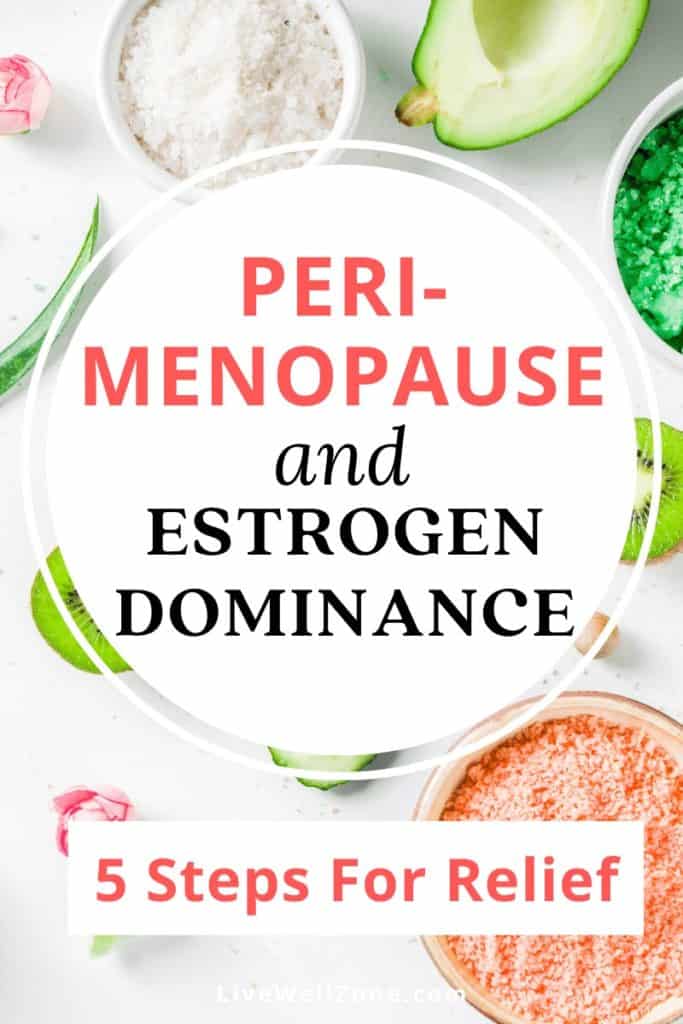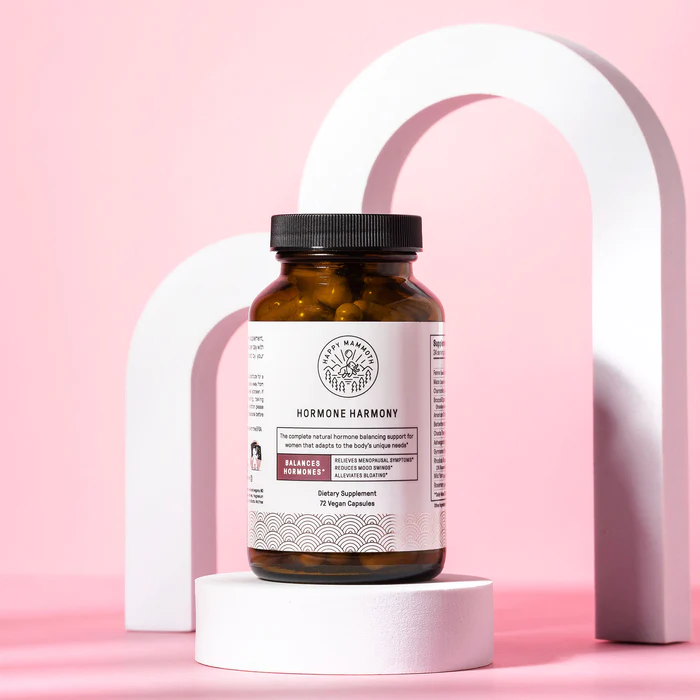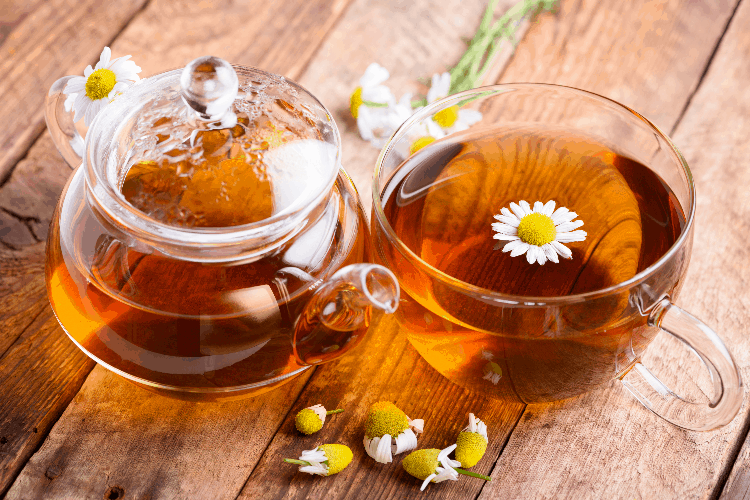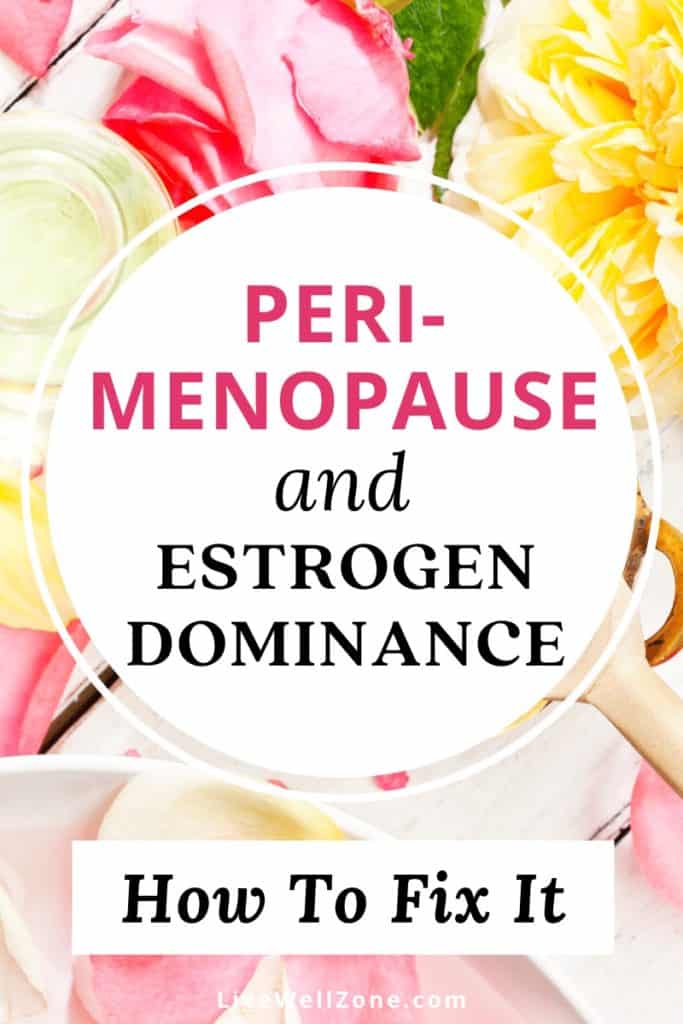
If estrogen is supposed to decrease as we approach menopause, then why do many women experience symptoms of estrogen dominance during perimenopause in particular?
From erratic – and often, heavy – periods to weight gain, as well as hot flashes, swollen breasts and mood swings…these symptoms are quite common during perimenopause.
And they’re linked to high estrogen.
So, which one is it: is estrogen supposed to be high or low during perimenopause?
Well, that’s what this post is going to answer for you.
We’re going to look at what the research says about estrogen fluctuations during perimenopause, as well as what you can do to take charge of your health.
Note: this post contains affiliate links and I earn a commission (at no additional cost to you) if you use them to make a purchase.
CAN YOU HAVE HIGH ESTROGEN DURING PERIMENOPAUSE?
Besides the fact that many women demonstrate symptoms of estrogen dominance during perimenopause, some studies also confirm that estrogen levels can often be elevated during this transition phase of life.
For example:
- One study compared perimenopausal women with heavy, irregular periods against perimenopausal women with normal cycles. The study found that the women with heavy periods had higher estrogen levels (source).
- Another study compared estrogen levels in women aged 47 with women aged 19 to 38. That study found that the 47-year olds had higher estrogen and lower progesterone, compared to the 19 – 38 age group (source).
In addition to all this, let’s not forget that progesterone also starts to decline during perimenopause.
This is because the ovaries, as a whole, are slowing down.
Since we need progesterone to counterbalance estrogen, if estrogen levels drop too much, then we have a situation where estrogen is relatively higher.

SO, DOES PERIMENOPAUSE CAUSE ESTROGEN DOMINANCE?
Although it’s tempting to blame perimenopause for estrogen dominance symptoms, there’s no research suggesting a causal link between the two.
Furthermore, if it was a given that perimenopause leads to estrogen dominance, then every woman going through this phase of life would exhibit those symptoms.
Yet, the reality is that there are women who never have these struggles and sail through perimenopause.
So, it’s more likely that there are dietary and lifestyle factors that are contributing to the estrogen dominance symptoms that some women experience.
In fact, when we look at our food supply and modern lifestyle, it’s easy to see how this can happen.
For example:
- many of the pesticides used in commercially grown food are estrogen-based. Therefore, these synthetic estrogens – aka xenoestrogens – can contribute to estrogen dominance.
- many women going through perimenopause tend to be very busy. It’s not unusual for a woman to be juggling a full-time career, kids, household responsibilities, the care of aging parents and more. This can lead to a build up of stress that affects estrogen, progesterone and other hormones.
In fact, that last piece – stress – is worth paying attention to because stress takes a toll on the nervous system and adrenals.
As this medical paper points out, hot flashes originate from the nervous system and they’re also regulated by the nervous system. In addition, sleep is also regulated by the nervous system.
So, based on this, we can start to see how an overworked nervous system contributes to hot flashes, insomnia and more.
Plus….the adrenals happen to be responsible for the production of sex hormones in menopause. However, if they’re too busy reacting to stress – i.e. producing cortisol – this will affect the levels of sex hormones.
SYMPTOMS OF ESTROGEN DOMINANCE DURING PERIMENOPAUSE
Although symptoms of estrogen dominance can vary from one woman to the next, some signs to look out for include (source):
- Weight gain
- Fatigue
- Erratic sleep patterns and difficulty sleeping
- Hot flashes
- Cold hands or feet
- Tender or swollen breasts
- Low libido
- Irregular menstrual cycles
- Heavy periods
- Hair loss
- Bloating
- Memory problems
- Brain fog
- Thyroid dysfunction
- Mood swings
HOW TO REVERSE ESTROGEN DOMINANCE IN PERIMENOPAUSE
Now that we have an understanding of how estrogen dominance contributes to perimenopause symptoms, let’s have a look at what you can do to lower estrogen naturally and get back to feeling like yourself again.
1. Increase Consumption of Cruciferous Veggies

Cruciferous veggies have high levels of the natural compound I3C (indole-3-carbinole), which supports the body in the detoxification of excess estrogen.
So, eating more cruciferous veggies is an important aspect of transitioning comfortably into menopause.
As far as which veggies to eat, choose from:
- Cauliflower
- Red and green cabbage
- Bok choy
- Arugula
- Radishes
- Kale
- Collard greens
- Mustard greens
- Turnips
- Brussel sprouts
- Broccoli
- Rutabaga
- Watercress
2. Use An All-in-One Herbal Supplement

With so many different symptoms associated with estrogen – and so many different systems in the body contributing to them – an herbal supplement can help you get relief (while you work on diet and lifestyle changes).
One supplement to look into is Hormone Harmony from the brand Happy Mammoth.
It’s a blend of herbs like:
- Maca (also a cruciferous root vegetable), ashwagandha and other adaptogens that help to balance cortisol and support our stress response system.
- Berberine and gymnema, both of which are used for insulin resistance. In addition, may also help with reducing sugar cravings.
- Anti-bloat and digestive support herbs like fennel.
- Calming herbs like chamomile and rosemary.
Based on the 10,000+ reviews – most of them very positive – this supplement may help with:
- hot flashes and night sweats.
- insomnia.
- bloating.
- PMS.
- mood.
- energy.
In addition, some reviewers say that this supplement helped them with weight loss.
That said, I wouldn’t look at this as a magic bullet for weight loss. Instead, use the supplement to support your body together with a healthy, hormone-friendly diet.
3. Support Liver Health
Your liver filters your blood so that it is free of toxins.
So, a healthy liver will go a long way toward helping you get rid of chemicals that are contributing to estrogen dominance.
So tips to keep in mind:
- Eat Bitters: Bitter foods are particularly beneficial for the liver so enjoy foods like endives, artichokes, green tea, dandelion greens, arugula and so on.
- Dive Into Beets: beets are a potent blood purifier. They also contain betaine, B-vitamins, iron, calcium and other compounds that are a must for proper liver function.
- Anti-inflammatory foods: pro-inflammatory foods (mainly packaged foods and foods loaded with other toxins) make your liver work harder. So, focus on eating more whole, nutrient-dense and unprocessed foods.
4. Manage Your Response To Stress

Stress is part of life. However, managing your response to stressful situations is what determines how stress affects your health.
So, take time to implement a self-care routine that matches your needs.
Some things to consider:
- Journal or hit a punching bag…whatever it takes to declutter your mind and let go of energy that isn’t serving you!
- Drink calming teas like chamomile, peppermint or lavender to induce a sense of relaxation.
- Book a monthly spa day for yourself. A friend of mine started doing this and considers it a lifesaver. It’s the one day of the month where she gets to just be with herself and replenish (while her hubby watches their kiddo)!
5. Consume More Organic Food
You have to eat.
And the last thing you need is for every meal to be a source of estrogen-based pesticides.
So, as much as you can, buy more organic produce.
This can be daunting!
If you’re overwhelmed by the thought of switching all your groceries to organic, then start with the Dirty Dozen.
The Dirty Dozen is the list of foods that have been found to have the highest amounts of pesticides. You want to make sure that you’re buying those in organic form!
The Environmental Working Group releases a dirty dozen list every year and you can get it here.
RELATED QUESTIONS
How can I balance my hormones during perimenopause?
Focus on lowering inflammation with nutrient-dense foods, reducing stress and using natural supplements that fill in any nutritional gaps that your current diet might be missing.
Where does estrogen come from after menopause?
After menopause estrogen is produced by your adrenal glands as well as your fat cells.
CONCLUSION
Hormonal imbalances during perimenopause are becoming more common.
As we’ve seen, a lot of it is due to the fact that we’re bombarded with hormone-disrupting compounds every day.
The good news is that you don’t have to live in a bubble and avoid all toxins in order to turn things around.
The basic dietary and lifestyle recommendations we’ve covered in this post can help you feel better and feel more at ease in your body.

Related Posts:
Perimenopause Diet: A Definitive Guide for Weight, Energy, Sleep & More
Herbs for Menopause Weight Gain (+ Best Supplement Recommendations)
Best Menopause Supplements Without Black Cohosh
How to Go Through Menopause Naturally: 7 Steps To Start Using Today
Hibiscus Tea and Menopause: Uses For Weight Loss, Hot Flashes and More
Essential Oils for Menopause: 11 Best Oils For Relief and How To Use Them
Menopause Smoothie: Best Ingredients To Use For Relief (+ Recipes)
The Only Essential Oil Roller Recipe For Hot Flashes You’ll Ever Need


hello , I am pari Ibrahimi I am 41 years old I have amenorrhea more then 6 months I am single , so i need more information please send me
Hi, you can go through the articles in the Menstrual Cycle section, as well as the Hormone Balance sections. There are various articles there that are helpful.